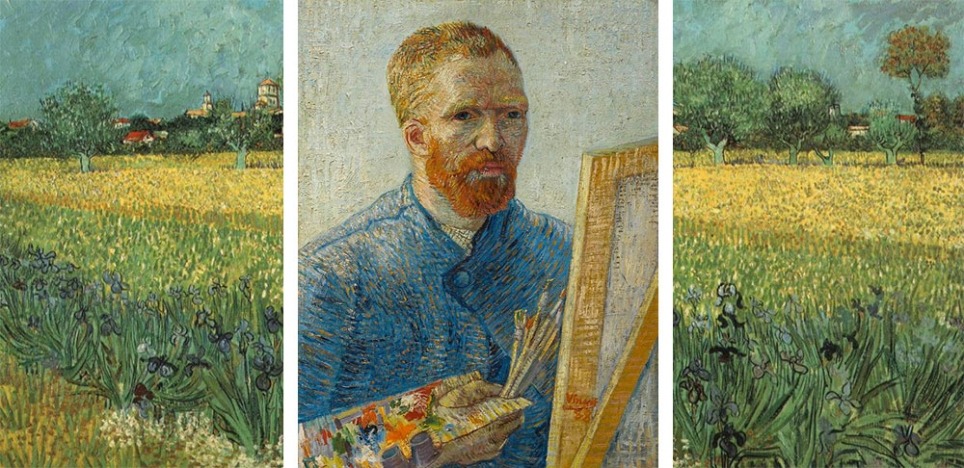Dutch post-impressionist painter Vincent Van Gogh was born in Zundert, Netherlands on March 30, 1853. Little is known about his childhood except that he was a quiet child who showed no extraordinary promise. At sixteen he began working for an art firm in which his Uncle Vincent was a partner. He was transferred from the Hague to London to Paris, where he became increasingly dissatisfied with his job. In early 1876, he was dismissed.
His interests soon took a strong religious turn. He wanted to become a minister, like his father. He spent a year in Amsterdam, preparing for his theology entrance exams, but preferred long walks in the countryside to studying. The uncle who had been helping him prepare suggested that he quit, and Vincent went to the Borinage mining region of Belgium as a lay minister, sharing people's poverty while teaching, visiting the sick, and giving Bible readings.
When Van Gogh wrote to his brother Theo, he included drawings which led Theo to encourage him to take up art. His desire to minister shone through this new endeavor. He wrote that he wished to provide "some memento in the form of drawings of paintings — not made to please any particular movement, but to express a sincere human feeling." Through persistent efforts and various opportunities to train, Van Gogh's skills rapidly progressed, taking off in earnest in 1886 when he moved to Paris and was exposed to the recent work of the Impressionists Claude Monet, Paul Cezanne, and Edouard Manet and post-impressionist Paul Gauguin.
He began to feel confident about his career choice, but by 1888 he started experiencing seizures which sapped him of his ability to work. He wrote to Theo, "I feel — a failure. That's it as far as I'm concerned — I feel that this is the destiny that I accept, that will never change." He entered the Saint-Paul-de-Mausole hospital in southern France where, when he was well enough, he would draw or paint the garden or the surroundings. His work was beginning to be appreciated, and when ten of his paintings were selected to be included in the annual "Salon des Indépendants" in Paris in March 1890, Gauguin said that they were the key to the exhibition.
In May 1890, Van Gogh moved north to Auvers-sur-Oise, a haven of quiet for artists that was also within visiting distance of Theo. He devoted himself to painting the gardens and wheat fields around the village, but money worries still weighed on him, and he was not sure when his health would again take a turn for the worse. On July 27 he shot himself in the chest. Hearing of this tragedy, Theo rushed from Paris and was able to be with Vincent when he died on July 29.
Vincent had only sold one painting during his lifetime. He left more than 900 paintings; they did not become famous until after his death.
To Name This Day . . .
 Quotes
Quotes
Which of these quotes gives you the strongest feel for the sensitivity Van Gogh had to spiritual values? Which helps you most to embody the values you hold dear?
"I tell you the more I think, the more I feel that there is nothing more truly artistic than to love people.
— Vincent Van Gogh in Everyday Sacred by Sue Bender
"How can I be useful, of what service can I be? There is something inside me, what can it be?"
— Vincent Van Gogh in Zen and the Art of Making a Living by Laurence G. Boldt
"Hope for better times is not a feeling, it is an action in the present."
— Vincent Van Gogh in Marriage from the Heart by Lois Kellerman and Nelly Bly
"It is looking at things for a long time that ripens and gives you deeper understanding."
— Vincent Van Gogh from his letters
"Van Gogh passionately paints the commonplace. There is more movement in one of his pots of flowers than in a classical painting of a horse race. Van Gogh's pictures were an interplay between his personal exuberance and the wondrous energies streaming out from familiar objects."
— Shaun McNiff in Earth Angels
"The healing gift that Van Gogh gave us is the passion of sight, a transfiguring love of this world."
— Michael Tucker in Dreaming with Open Eyes
 Spiritual Practice
Spiritual Practice
"Admire as much as you can," wrote Van Gogh in one of his letters to Theo; "most people do not admire enough. . . . Always take many walks and keep your love of nature, for that is the true way to learn to understand art more and more. Painters understand and love her and teach us to see her."
Take time today simply to admire what you see or even what you touch, for Van Gogh had great sensitivity for textures.
 Films
Films
This trailer to the film At Eternity's Gate speaks to Van Gogh's insight that "a grain of madness is the best art." After watching it, in light of Van Gogh's courage, consider what elements of social convention might be keeping you from fully expressing the depths of your creativity.
You will find reviews of more films as well as books about Vincent Van Gogh in the "Also Recommended" box.
